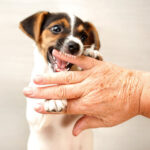Why Does My Dog Roll On His Toys
Why Does My Dog Roll on His Toys: The Surprising Reasons Behind this Common Behavior
If you’re a dog owner, you may have noticed your furry friend rolling on his toys from time to time. You may wonder why he does that, especially if he already played with them or chewed them. Is it just a random quirk of canine behavior, or does it serve some purpose? In this article, we’ll explore the possible reasons why dogs roll on their toys and what it tells us about their instincts, senses, and emotions.
Introduction: The Mystery of Rolling Dogs
Have you ever seen a dog rolling on his back, legs up in the air, with a toy or a ball between his paws? Or maybe you’ve witnessed your own dog pushing a toy around with his nose or rubbing it against his body. While these actions may seem cute or funny, they raise some interesting questions for dog lovers and experts alike. Why would a dog roll on something he already played with? Is he trying to scratch an itch or get rid of a scent? Is he showing off his dominance or marking his territory? Or is he simply having fun and expressing himself in his unique way?
While there’s no single answer to these questions, there are several possible explanations for why dogs roll on their toys. Some of them relate to their natural instincts and behaviors as domesticated descendants of wolves. Others reflect their sensory preferences and responses to different stimuli. Still others reveal their emotional states and social contexts. By understanding these factors, we can appreciate our dogs’ quirks and needs better and enhance our bond with them.
Section 1: Instincts and Behaviors
Dogs are not only cute and cuddly pets but also complex creatures with deep-rooted instincts and behaviors that evolved over thousands of years. As descendants of wolves, dogs share many traits with their wild ancestors, including hunting, scavenging, and socializing. Some of these traits can manifest in seemingly odd or random ways, such as rolling on toys. Here are some possible explanations based on canine instincts:
1. Scent marking – Wolves use their urine, feces, and other bodily secretions to mark their territory and communicate with other pack members. They may also roll on smelly substances to enhance their scent and mask their own odor. Dogs, being closely related to wolves, may retain this instinct to some extent and roll on toys that have a strong smell, such as food or another dog’s scent.
2. Play behavior – Puppies and young dogs often engage in play behavior that involves mouthing, biting, chasing, and wrestling with objects or each other. Rolling on toys may be a part of this playful behavior, as it allows them to interact with the toy in different ways and explore its texture, shape, and taste.
3. Submission or avoidance – In wolf packs, lower-ranking members may exhibit submissive behaviors towards higher-ranking members by lying down or rolling over in front of them. This posture signals deference and non-aggression. Similarly, dogs may roll on their backs to show submission or avoid conflict when they feel threatened or intimidated by a person or another dog.
Section 2: Senses and Preferences
Dogs rely heavily on their senses to navigate their environment, detect potential dangers or rewards, and communicate with humans and other animals. Their sense of smell is especially acute, as they have up to 300 million olfactory receptors compared to our mere 5 million. This heightened sense of smell can influence how dogs interact with objects and people around them. Here are some possible explanations based on canine senses:
1. Sensory stimulation – Rolling on toys may provide sensory stimulation for dogs by activating different parts of their body, such as their muscles, skin, and ears. It may also expose them to different textures, scents, and sounds that they find intriguing or pleasurable.
2. Self-grooming – Dogs are known for their grooming rituals, which involve licking, scratching, and rubbing themselves to maintain their hygiene and comfort. Rolling on toys may serve as a form of self-grooming that helps them relieve an itch, clean their fur, or massage their muscles.
3. Object fixation – Some dogs develop a fixation on certain objects or toys that they become attached to and roll on frequently. This fixation may stem from a positive association with the object, such as receiving treats or attention when playing with it, or from a compulsive behavior that gives them a sense of control or comfort.
Section 3: Emotions and Social Context
Dogs are not just instinct-driven animals but also social creatures that form bonds with humans and other dogs. Their emotions can range from joy and excitement to fear and anxiety, depending on their experiences and environment. These emotions can influence how dogs behave towards objects and people around them. Here are some possible explanations based on canine emotions:
1. Playfulness and happiness – Dogs may roll on toys out of sheer joy and playfulness, especially if they associate the toy with fun activities like fetching, tugging, or chewing. Rolling on toys may be a way for them to express their exuberance and share their happiness with us.
2. Anxiety and stress – Dogs may roll on toys as a coping mechanism when they feel anxious or stressed by external factors such as loud noises, separation anxiety, or unfamiliar situations. Rolling on toys may help them release tension and feel more grounded in their familiar surroundings.
3. Attention-seeking or bonding – Dogs may roll on toys to get our attention or bond with us emotionally. Rolling on toys may be a way for them to initiate playtime or cuddle time with us, or to show us affection by sharing their favorite toy with us.
Conclusion: The Many Faces of Rolling Dogs
As we’ve seen, there are many possible reasons why dogs roll on their toys, ranging from instinctual behaviors to sensory preferences and emotional states. While we may never fully understand the complexity of canine behavior, we can appreciate our dogs’ quirks and needs by observing them closely and responding to them appropriately. If your dog rolls on his toys frequently, try to figure out what triggers this behavior and how you can enhance his enjoyment or comfort. Whether he’s rolling on his back with a ball in his paws or pushing a squeaky toy with his nose, he’s showing you a glimpse of his unique personality and spirit. So next time you see your dog rolling on his toys, join him in the fun and make some jokes about it. After all, life is better when you roll with your dog!



